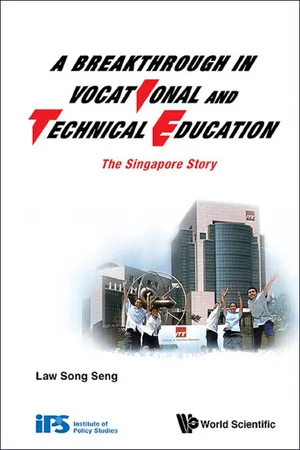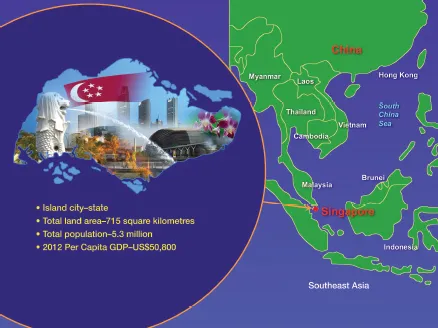![]()
![]()
Chapter 1
Historical Perspectives
Learning a trade had long been associated with acquiring practical hands-on skills through on-the-job training. In this learning process, vocational knowledge and skills was transferred from a master craftsman to an apprentice. Historically, this was the prevailing mode of skills development leading up to the early stages of industrialisation in the 1900s. Its evolution into a more formal and structured system of apprenticeship is best exemplified by the dual system of apprenticeship still practised in Germany, Switzerland and the Nordic countries today. Under this system, an apprentice undertakes practical training in a company, which is supplemented by theoretical lessons in a vocational school. Such a system, long established by tradition and strongly supported by unions and chambers of commerce and industry, has proven to be a highly successful model in developing a quality and professional workforce.
The concept of extending formal education to include vocational training within the school system as preparation for work was a more recent development in modern society. It was largely driven by a new demand for vocational and technical skills arising from emerging technologies in an industrial economy. Basic education was no longer sufficient as a transition from school to the world of work. As such, vocational education was instituted as an option in the school system to better prepare students with employable skills. In the process, vocational schools, technical institutes and community colleges evolved and are now a common feature in many educational systems.
VOCATIONAL AND TECHNICAL EDUCATION
What is “Vocational and Technical Education” (VTE)? VTE does not stand alone. It is a subsystem of the larger national education and training system, including training institutes, schools, polytechnics and universities. As a system, it is shaped by local conditions and the wider political, social and economic environment. As such, while the missions and challenges may be the same, the systems do vary across countries. In short, there is no one “universal” model that characterises all VTE systems. Other terminologies commonly used include “Vocational Education”, “Vocational Training”, “Technical Education” or “Technical and Vocational Education and Training” (TVET). In Singapore, the term “VTE” (Box 1.1) is broadly used to include the Institute of Technical Education (ITE) and polytechnics. As post-secondary education institutions, they provide VTE for about 65 per cent of a school cohort in Singapore.1
However, ITE is not a polytechnic. Its focus is the lower end of VTE in terms of levels of vocational and technical qualifications. It provides a vocationally oriented education that equips its graduates with skills and standards for occupations in major sectors of business and industry. ITE graduates work as technicians and skilled personnel. They are certified under the National ITE Certificate (Nitec) competency-based system of certification. As such, they do not have to undertake further public trade tests, as may be the case in other national education systems. The kind of VTE offered by ITE is therefore not the same as vocational education generally associated with vocational high schools. Since 1973, Singapore decided to phase out vocational education in schools and replace it with pre-employment VTE in a specialised institution outside the school system. With further adaptation, this full-time institution-based model has evolved into the present-day ITE and proven to serve Singapore well in a globally competitive knowledge economy.
According to a Six-Nation Research Study (Metzger et al., 2001), there are “core attributes” that help define VTE:
- What: VTE is typically that part of a student’s school-to-work transition. It is education and training for employment. It enables students to acquire knowledge and practical skills for specific jobs or occupations. VTE is traditionally not a university or polytechnic education.
- Who: VTE is primarily focused on young people aged 16 to 20, although it can apply to older working adults who undertake VTE on a part-time Continuing Education and Training (CET) basis.
- Why: Economic and social reasons require that a country sustain a high quality VTE system. VTE’s importance rests in a country’s responsibility to members of its younger generations who, for various reasons, do not engage in higher education as a first step in their professional careers. Failure to meet this responsibility can result in increased social costs and worse still, high youth unemployment. Second, VTE can play an important role in the process of socialisation for young people. Third, VTE has an effect on a country’s economic system; in particular, the quality, productivity and competitiveness of the workforce. Finally, VTE is an important long-term investment in human capital development for individuals, companies and country.
However, certain “attributes” vary substantially across national settings:
- Where: VTE can take place entirely in school or in the workplace, as well as in dual settings that integrate formal schooling and the workplace.
- When: VTE can take place at different stages of the educational system. Typically, it occurs either during the later part of secondary education or at the post-secondary level. This is a policy choice depending on the preference for the duration of general education and shared responsibility with business and industry for VTE.
- How: VTE can vary according to the extent to which the learning is formalised. Typically, school-based VTE appears to be as formalised as general education, while VTE in the workplace can be as structured as school-based learning or as informal as learning on the job.
BEGINNINGS OF VTE PRIOR TO 1960
Singapore was founded by Sir Stamford Raffles as a British colony in 1819 (Box 1.2). The first Government Trade School in Singapore was established in 1930 (Chiang, 1998; Law, 1984). Pre-apprenticeship courses were offered to primary school leavers in electrical, radio, plumbing, automotive mechanics, fitting and turning. Originally located at Newton Circus on Scotts Road, it relocated to larger premises at Balestier Road in 1940. Reflecting the uncertainty of the time, it was renamed Balestier Technical (Trade) School in 1947, Junior Technical School in 1951 and Balestier Junior Trade School in 1956. Separately, another trade school for boys, the St Joseph’s Trade School, was established by the Roman Catholic Church in 1938. Located in Upper Bukit Timah, it was rebuilt in 1970 and the name changed to Boys’ Town Vocational Institute. These were the humble beginnings of VTE in Singapore prior to 1960. The interest in education was very much limited to the colonial government’s schools that used English as their medium of instruction, and ethnic associations’ vernacular schools that conducted classes in Chinese, Malay and Tamil. From the economic perspective, there was no real reason to pay more attention than was necessary, as the economy then did not demand a highly skilled workforce.
BOX 1.1 FACTSHEET ON VTE IN SINGAPORE
In the Singapore context, the term “Vocational and Technical Education (VTE)” is broadly used to include the vocational and career-orientated technical education and training provided by the Institute of Technical Education (ITE) and polytechnics. Both are post-secondary educational institutions with ITE focusing on the lower end of the VTE system for the less academically inclined students. The United Nations Educational, Scientific and Cultural Organization (UNESCO) term covering this broad scope of education and training activities, including VTE, is “Technical and Vocational Education and Training” (TVET). The term “TVET” was first adopted by participants at the TVET World Congress in 1999. It is an all-encompassing term comprising formal and non-formal vocational education, technical training and skills development at various levels for school leavers, out-of-school youth and adult learners.
Polytechnics in Singapore offer a wide range of three-year diploma courses in preparing school leavers with the General Certificate of Education “Ordinary” or GCE “O” level qualification for jobs as technologists, supervisors and other para-professionals. On the other hand, ITE’s two-year national certificate courses are more hands-on, competency-based and aimed at training technicians and personnel in skilled occupations for major sectors of the economy in manufacturing, finance and business, technical support and services. The minimum entry requirement for ITE is a successful completion of ten years of general education.
ITE operates as a statutory board under the purview of the Ministry of Education. Viewed as an integral part of the national system of education and training, ITE addresses the needs of the less academically inclined cohort.
The Vocational and Industrial Training Board (VITB) was the predecessor to the present-day ITE. Initially offered as vocational education in secondary schools in the 1960s, VTE soon evolved into a system separate from the schools — first under the Industrial Training Board (1973), then VITB (1979) and ITE (1992).
BOX 1.2 FACTSHEET ON SINGAPORE
A former British colony founded by Sir Stamford Raffles in 1819, Singapore is today a modern city-state strategically located in Southeast Asia. It became an independent nation in 1965 through separation from Malaysia.
The story of its transformation, From Third World To First — The Singapore Story 1965–2000, as told by first Prime Minister Lee Kuan Yew (Lee, 2000) was equally dramatic. In the preface to the book, Mr Lee said,
“The years after 1965 were hectic and filled with anxiety, as we struggled to find our feet. We were relieved when we found in 1971 that we had created enough jobs to avoid heavy unemployment even though the British withdrew their forces from Singapore… Our climb from per capital GDP of US$400 in 1959 (when I took office as prime minister) to more than US$12,000 in 1990 (when I stepped down) and US$22,000 in 1999 took place at a time of immense political and economic changes in the world…”
This was a multi-racial society with over five million people living on a small island of 715 square kilometres, and per capital GDP was US$50,800 in 2012. Singapore is today a global centre for business, finance, industry and services. As people are its only resource, Singapore places the highest priority on the education, training and skills development of its people.
Three notable developments, however, began to shape the directions for change. The first was the formation of the Singapore Council of Adult Education (CAE) in 1950, which later became the Adult Education Board (AEB) in 1960. The principal activities of the Board were to provide opportunities in language learning, academic education and further education for out-of-school youth and working adults in the evenings and weekends on a part-time basis.
The second major development was the Dobby Report (Dobby, 1953), which recommended the establishment of Singapore’s first polytechnic, the Singapore Polytechnic in 1954. The report also highlighted the need for technical education in schools. This resulted in the government opening the first two secondary technical schools, namely, the Tanjong Katong Secondary Technical School and Queenstown Secondary Technical School in 1956. These were positioned as premier schools to promote the value of technical education and to attract the best students to take up this course of study. The third was the establishment in 1956 of the Joint Advisory Council for Apprenticeship Training, which led to the formulation of apprenticeship training schemes in conjunction with the Ministry of Labour.
BUILD-UP IN THE 1960s
A slow pace and state of affairs with respect to VTE was to continue until 1959 when Singapore attained self-government from the British. There was a sense of urgency in pushing for social and economic development with a new leadership in power under the People’s Action Party (PAP). It became apparent that the commercial and service sectors alone could not expand sufficiently to provide jobs for the growing number of school leavers. In search for a solution, the government soon adopted a policy of diversification through industrialisation to accelerate economic growth. With the lack of natural resources, education and training became a top priority and vehicle in maximising the potential of its people. In tandem with this change, an increasing emphasis was placed on a parallel development of vocational and technical education in schools.
As a trading port, Singapore did not have the benefits of tradition or the experience of a culture in manufacturing knowledge and values. There was no ready supply of vocational and technical skills. The government needed to learn, and learn quickly, from the best practices in the developed world. The significant step was the establishment of the first vocational institute, the Singapore Vocational Institute (SVI), in 1964 under the Ministry of Education. The result of a recommendation from the Commission of Inquiry into Vocational and Technical Education (Chan, 1961), the SVI was a reorganisation of the former Balestier Trade School. It took over the full-time two-year craft courses run by the Singapore Polytechnic. School leavers with at least two years of secondary education took courses ranging from carpentry to plumbing and joinery, refrigeration and air-conditioning, mechanical engineering practice, electrical fitting, motor vehicle mechanics, engineering drawing, machine woodworking, reinforced concrete and brickwork.
As was the practice at the time, day-release — where employers allow employees to attend courses by taking the same day or days off work each week — and evening courses were conducted for working adults who were employed in related technical occupations. Graduates received the Craft or Advanced Craft Certificates awarded by the Ministry of Education. Another recommendation of the Commission was the establishment of two-year secondary vocational schools for primary school leavers who failed to qualify for the more prestigious academic or technical streams leading to the General Certificate of Education “Ordinary” or GCE “O” level examination. Students who completed secondary vocational education could progress for further craft training at the SVI.
With the increasing pace of industrialisation, there was growing concern on how best to expeditiously expand the vocational training capacity so as to meet the manpower requirements of the emerging industries. This task was undertaken by the National Industrial Council in 1968. As a result, the Technical Education Department (TED) was set up within the Ministry of Education to administer and oversee the development of technical schools, vocational and technical institutes, industrial training centres and technical teacher training. The secondary vocational schools, which only provided basic technical skills, were phased out and some were converted into Industrial Training Centres. This was a clear response to the national task in skills development. During this rapid pace of rationalisation and development, the apprenticeship schemes were transferred from the Ministry of Labour to the TED in 1969.
In 1969, the Singapore Technical Institute (STI), an institute dedicated to the training of industrial technicians, was established. In response to the needs of industry, these technicians represented the bridges and worked at a level between the graduates of vocational institutes and the diploma holders of the polytechnics. STI graduates received the Industrial Technician Certificate (ITC) after two years of full-time training. Employment surveys of graduates and feedback from employers had shown that these graduates who had the GCE “O” level qualification and practical skills training were versatile and successful in employment and further career development. In view of their technical training, the graduates were also seen as an ideal pool of potential teachers in technical schools. A highly valued qualification, the ITC has since been replaced by the Higher National ITE Certificate, or Higher Nitec, under ITE’s current system of certification in 2002.
FORMALISATION OF VOCATIONAL TRAINING SYSTEM IN THE 1970s
By 1973, TED had developed a training infrastructure that was ready for the next major phase of development. The number of graduates had increased more than 10-fold from 324 in 1968 to over 4,000 in 1972. A new governance structure under a separate authority with greater autonomy and adaptability was deemed necessary to better respond to the needs of a rapidly changing economy. Thus, the Industrial Training Board (ITB) was created in 1973 to centralise, coordinate and intensify industrial training. The late Mr Sng Yew Chong, who was formerly a science teacher and Director of TED, became the first Director of ITB. In policy terms, it meant that for the first time, the system of vocational training was taken outside the school system and placed under a statutory board.
A quasi-autonomous agency created through an Act of Parliament with specific provisions, rights and accountability for industrial training, the ITB had greater autonomy and flexibility in performing its functions. In contrast, training under the TED was administered as a regular civil service department with its more hierarchical governance structure. The ITB, on the other hand, was constituted as a tripartite board with representation from th...



